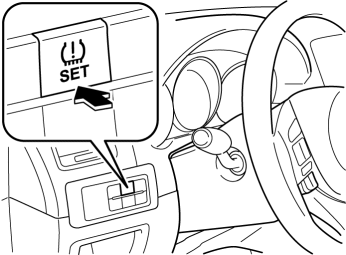Mazda CX-5 Service & Repair Manual: Tire Pressure Monitoring System Initialization Procedure
-
Perform the tire pressure monitoring system initialization when the following operations have been performed:
-
Tire pressures have been adjusted
-
Tires or wheels have been replaced
-
Tires have been rotated
-
DSC HU/CM replaced
-
DSC HU/CM connector disconnected
-
Battery replaced
-
Negative battery cable is disconnected
1. Park the vehicle on safe, level ground.
2. Adjust all four tire pressures to the specification while the tires are cold..
3. Switch the ignition ON (engine off or on).
4. Press and hold the tire pressure monitoring system set switch.

5. Press and hold the tire pressure monitoring system set switch until the tire pressure monitoring system warning light flashes 1 or 2 times and the indicator alarm sounds 1 time.
NOTE:
-
When the tire pressure monitoring system initialization is performed, learning initiates. Learning is completed by driving the vehicle for 20 min.
-
While the tire pressure monitoring system is undergoing learning, its primary functions do not operate.
 Tire Pressure Monitoring System (TPMS)
Tire Pressure Monitoring System (TPMS)
Purpose, Outline
The tire pressure monitoring system monitors the tire pressure of all 4 tires.
If the tire pressure of 1 tire or more becomes excessively low, the driver is
notified.
...
 Tire Pressure Monitoring System Set Switch
Tire Pressure Monitoring System Set Switch
Purpose
The tire pressure monitoring system set switch is used to initialize the
tire pressure monitoring system.
Construction, Operation
The tire pressure monitoring syst ...
Other materials:
Start Stop Unit
Purpose
Performs control of several systems based on input/output signals from switches.
Function
The start stop unit controls systems based on the input/output signals.
The functions which are controlled are as follows:
Control Table
Control ...
Camshaft Position (CMP) Sensor Removal/Installation
CAUTION:
When replacing the CMP sensor, make sure there is no foreign material on
it such as metal shavings. If it is installed with foreign material, the sensor
output signal will malfunction resulting from fluctuation in magnetic flux and
cause a deterioration in engine control.
...
Ambient Temperature Sensor [Manual Air Conditioner]
Purpose
The ambient temperature sensor detects the ambient temperature.
Function
The ambient temperature sensor converts the detected temperature to an electric
signal.
Construction
A thermistor-type ambient temperature sensor has been adopted.
The ambient ...
